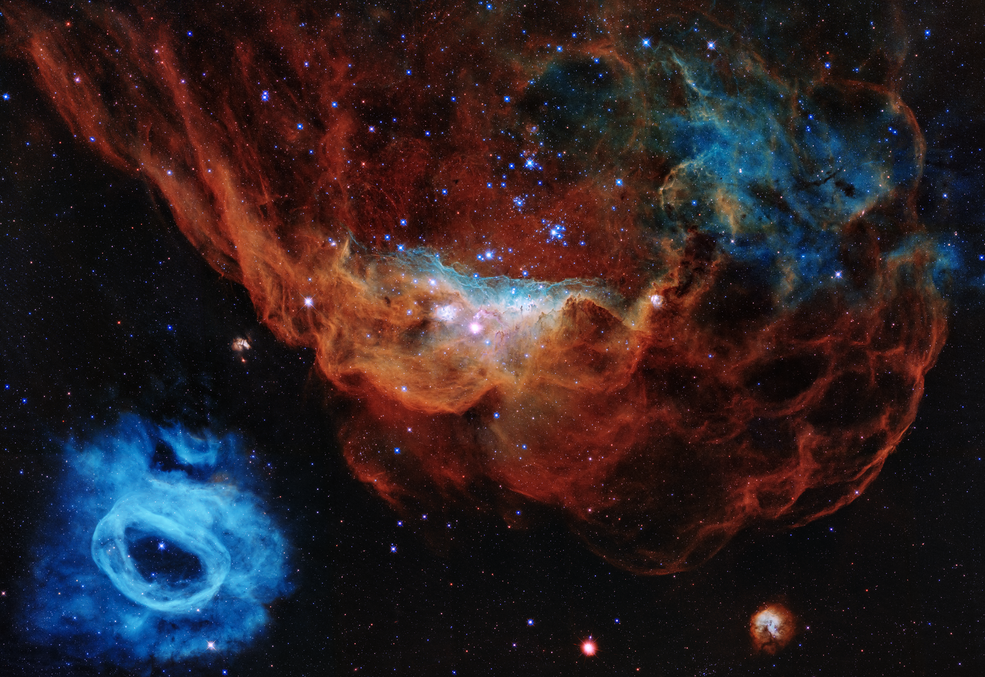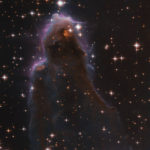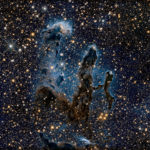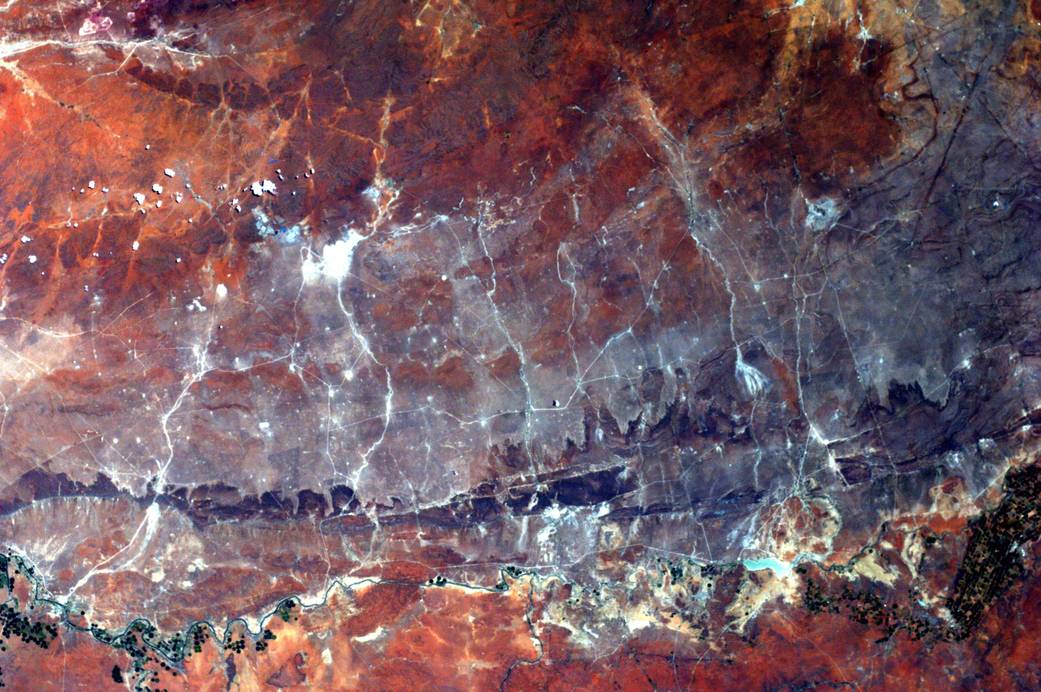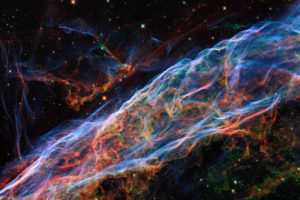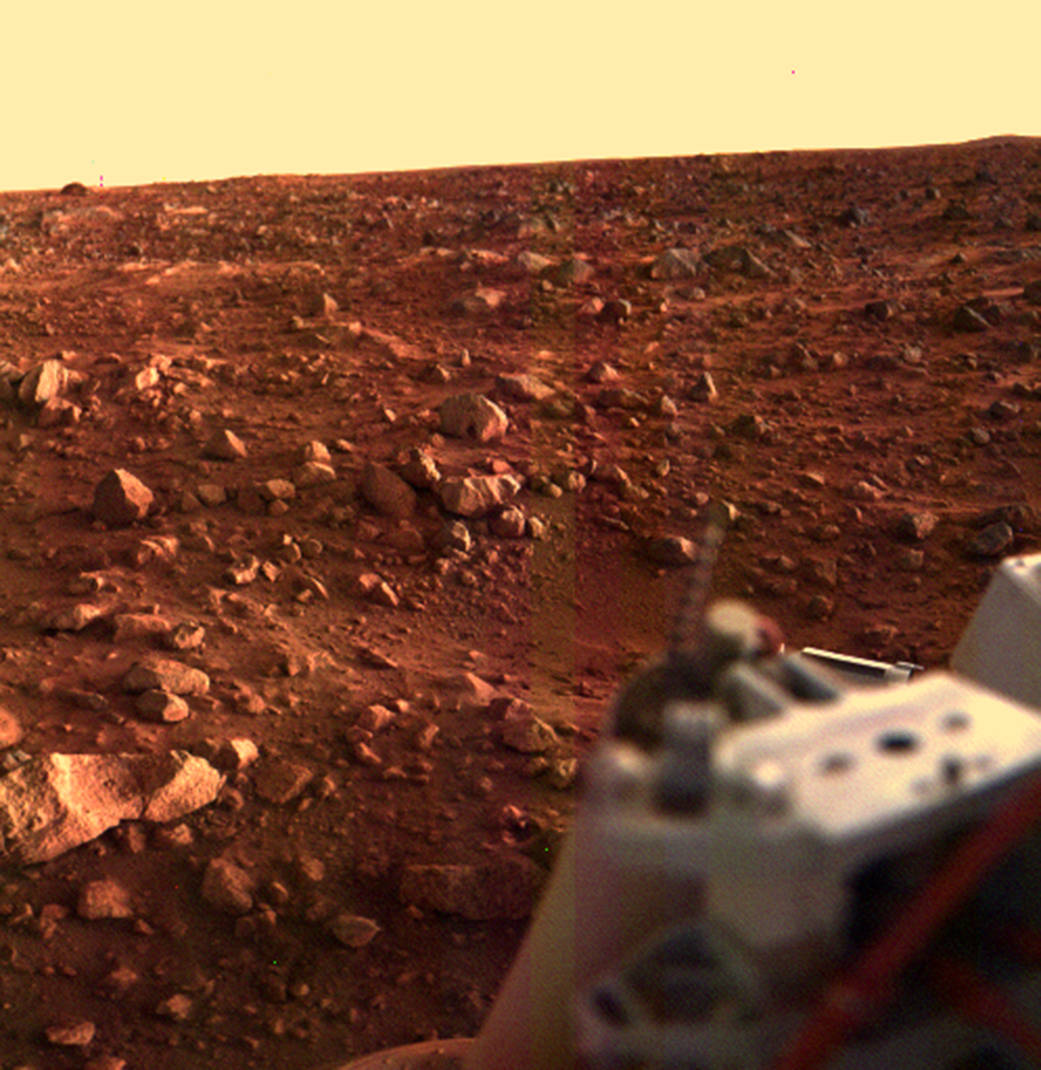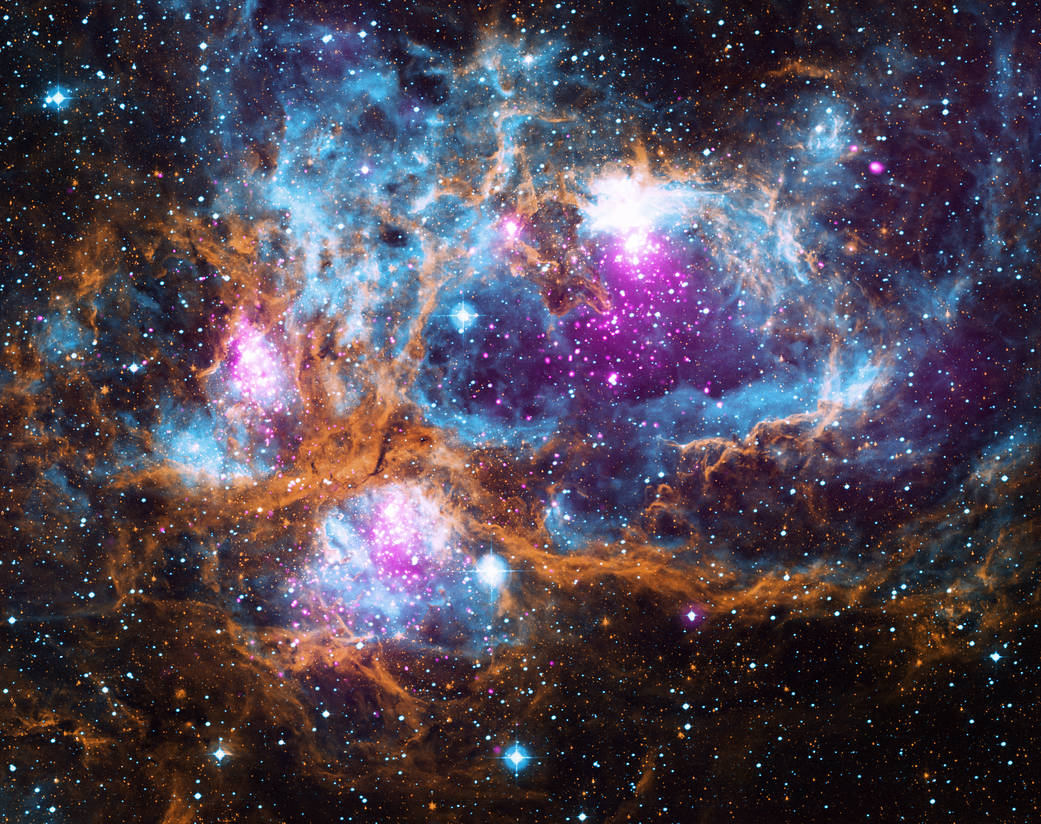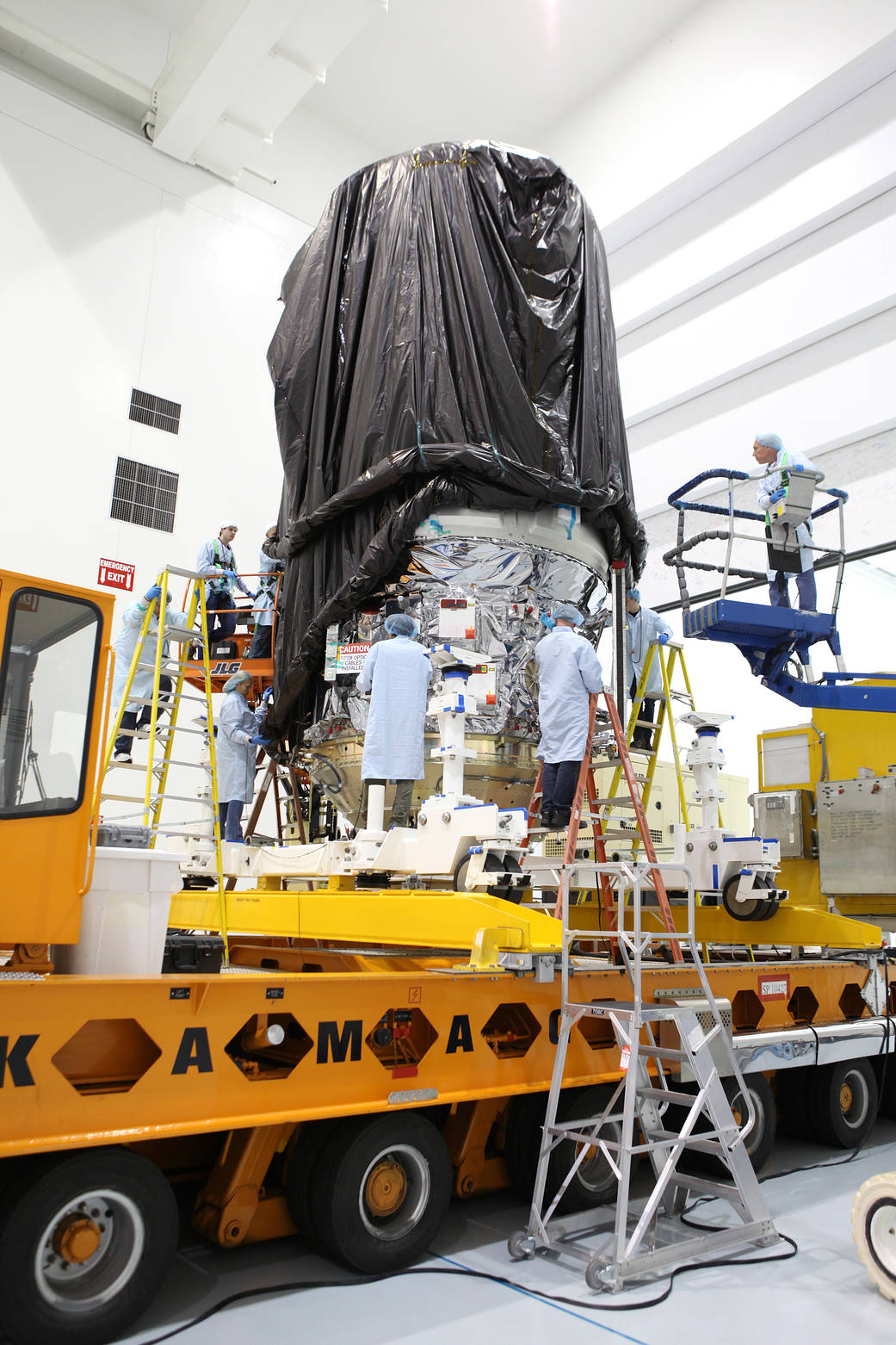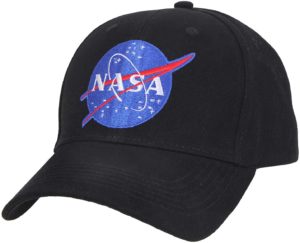NASAがハッブル宇宙望遠鏡による30年間の美しい画像を今日の1枚に掲載するとともに3分30秒の動画にまとめています。
英語のナレーションも入っていますので、英語リスニング力の訓練にいかがでしょうか?
Credits: NASA, ESA and STScI
画像の説明
A colorful image resembling a cosmic version of an undersea world teeming with stars is being released to commemorate the Hubble Space Telescope’s 30 years of viewing the wonders of space. In the Hubble portrait, the giant red nebula (NGC 2014) and its smaller blue neighbor (NGC 2020) are part of a vast star-forming region in the Large Magellanic Cloud, a satellite galaxy of the Milky Way, located 163,000 light-years away. The image is nicknamed the “Cosmic Reef,” because NGC 2014 resembles part of a coral reef floating in a vast sea of stars. Some of the stars in NGC 2014 are monsters. The nebula’s sparkling centerpiece is a grouping of bright, hefty stars, each 10 to 20 times more massive than our Sun. The seemingly isolated blue nebula at lower left (NGC 2020) has been created by a solitary mammoth star 200,000 times brighter than our Sun. The blue gas was ejected by the star through a series of eruptive events during which it lost part of its outer envelope of material.
ハッブル宇宙望遠鏡が30年間宇宙の驚きに満ちた観測を続けてきた30周年記念として、星が満ち溢れた海底のようなカラフルな宇宙の画像を掲載しました。このハッブルの画像にある巨大な赤い星雲(NGC 2014)とその隣にある小さい青色の星雲(NGC 2020)は、163,000光年先に位置する天の川銀河である大マゼラン星雲の広大な星形成領域の一部です。NGC 2014は広大な星の海に浮かぶサンゴ礁の一部に似ているため「コズミックリーフ」というニックネームで呼ばれています。 NGC 2014の星のいくつかは巨大な星です。星雲のきらめく中心にあるのは、太陽の10倍から20倍の大きさの明るく重い星の集まりです。左下(NGC 2020)で孤立しているように見える青い星雲は、太陽よりも200,000倍明るい単独の超巨大な星でできています。青いガスは一連の爆発により星から放出され、その間に表面の一部が失われました。
NASA公式サイトの記事と和訳
Hubble Marks 30 Years in Space With Tapestry of Blazing Starbirth
NASA is celebrating the Hubble Space Telescope’s 30 years of unlocking the beauty and mystery of space by unveiling a stunning new portrait of a firestorm of starbirth in a neighboring galaxy.
In this Hubble portrait, the giant red nebula (NGC 2014) and its smaller blue neighbor (NGC 2020) are part of a vast star-forming region in the Large Magellanic Cloud, a satellite galaxy of the Milky Way, located 163,000 light-years away. The image is nicknamed the “Cosmic Reef,” because it resembles an undersea world.
NASAは、ハッブル宇宙望遠鏡の30年におよぶ宇宙の美しさと謎を解き明かす観測活動が30周年を迎えることを、近隣する銀河の星の誕生の驚くべき新しい画像の公開により祝福しています。
このハッブルの撮影画像の、巨大な赤い星雲(NGC 2014)とその隣の小さな青い星雲(NGC 2020)は、163,000光年先に位置する天の川の衛星銀河である大マゼラン星雲の広大な星形成領域の一部です。画像は海底世界に似ていることから「コズミックリーフ」という愛称で呼ばれています。
Thirty years ago, on April 24, 1990, Hubble was carried aloft from NASA’s Kennedy Space Center in Florida aboard the space shuttle Discovery, along with a five-astronaut crew. Deployed into Earth orbit a day later, the telescope opened a new eye onto the cosmos that has been transformative for our civilization.
30年前の1990年4月24日、ハッブルは5人の宇宙飛行士と共に、フロリダ州にあるNASAのケネディ宇宙センターからスペースシャトルディスカバリー号に搭載されて宇宙中に運ばれました。 1日後に地球の軌道に配置された望遠鏡は、私たちの文明に変革をもたらしてきた宇宙に向かって、新たな目を開けました。
Hubble is revolutionizing modern astronomy, not only for scientists, but also by taking the public on a wondrous journey of exploration and discovery. Hubble’s never-ending, breathtaking celestial snapshots provide a visual shorthand for Hubble’s top scientific achievements. Unlike any space telescope before it, Hubble made astronomy relevant, engaging and accessible for people of all ages. The space telescope’s iconic imagery has redefined our view of the universe and our place in time and space.
ハッブルは、科学者だけでなく一般人も巻き込んで探査と発見の驚くべきページを開き、現代天文学に革命を起こしています。ハッブルの終わりのない、息をのむ天体の観測画像は、最高の視覚的な科学的成果をスピーディに提供してくれます。それ以前の宇宙望遠鏡とは異なり、ハッブルは天文学をあらゆる年齢の人々が観測成果にアクセスできるようになっています。宇宙望遠鏡による象徴的な画像により、私たちの宇宙観と時間と空間を再定義することができるようになりました。
“Hubble has given us stunning insights about the universe, from nearby planets to the farthest galaxies we have seen so far,” said Thomas Zurbuchen, associate administrator for science at NASA Headquarters in Washington, D.C. “It was revolutionary to launch such a large telescope 30 years ago, and this astronomy powerhouse is still delivering revolutionary science today. Its spectacular images have captured the imagination for decades, and will continue to inspire humanity for years to come.”
ワシントンDCにあるNASA本部の科学担当副管理者であるトマス・ザブシェンは、次のように述べています。「このような大きな望遠鏡を打ち上げることは革命的でした。 30年前に天文学の大国であったアメリカ合衆国は、今でも革新的な科学を提供し続けています。そこで何十年にもわたって撮影された壮大な画像の数々は、今後も人類を宇宙への関心を突き動かし続けます。」
Unencumbered by Earth’s blurring atmosphere, the space observatory unveils the universe in unprecedented crystal-clear sharpness across a broad range of wavelengths, from ultraviolet to near-infrared light.
宇宙における天文台は、地球のぼやけた大気に邪魔されることなく、紫外線から近赤外光までの幅広い波長範囲にわたって、宇宙を前例のないクリアで精密に明らかにします。
On April 24, 2020, the Hubble Space Telescope celebrates its 30th year in orbit by premiering a never-before-seen view of two beautiful nebulas named NGC 2020 and NGC 2014. Hubble’s senior project scientist, Dr. Jennifer Wiseman, takes us on a tour of this stunning new image, describes the telescope’s current health, and summarizes some of Hubble’s contributions to astronomy during its 30-year career.
Credits: NASA’s Goddard Space Flight Center
Hubble’s top accomplishments include measuring the expansion and acceleration rate of the universe; finding that black holes are common among galaxies; characterizing the atmospheres of planets around other stars; monitoring weather changes on planets across our solar system; and looking back in time across 97% of the universe to chronicle the birth and evolution of stars and galaxies.
ハッブルの最大の成果はいくつも数え上げることができます:宇宙の膨張率と加速率の測定、銀河には共通してブラックホールが存在していること、惑星の周囲の大気の特徴把握、太陽系全体の惑星大気の変化の監視、星と銀河の誕生と進化を宇宙の時間推移の97%までさかのぼっての調査、などです。
Hubble has yielded to date 1.4 million observations and provided data that astronomers around the world have used to write more than 17,000 peer-reviewed scientific publications, making it the most prolific space observatory in history. Its archival data alone will fuel future astronomy research for generations to come.
ハッブルはこれまでに140万回におよぶ観測を実施し、世界中の天文学者が17,000を超える科学出版物を執筆するのに使用したデータを提供しており、史上最も多くの成果を生み出した宇宙観測所となっています。そのアーカイブデータだけでも次世代の天文学の研究に多大な貢献をすることでしょう。
Hubble’s longevity can be attributed to five space shuttle servicing missions, from 1993 to 2009, in which astronauts upgraded the telescope with advanced instruments, new electronics and on-orbit repairs. The venerable observatory, with its suite of cameras and other instruments, is expected to stay operational through the 2020s, in synergy with the upcoming James Webb Space Telescope.
ハッブルの装置寿命を延ばすために、1993年から2009年までに5度にわたるスペースシャトルによるメンテナンスが実施されました。そのミッションでは、宇宙飛行士が軌道上で、望遠鏡の機器を交換し、新しい電子機器を追加し、保守しました。一連のカメラやその他の機器を備えたハッブル宇宙望遠鏡は、2020年代まで運用を継続することができるようになり、今後のジェームズウェッブ宇宙望遠鏡との相乗効果を発揮するでしょう。
The Hubble Space Telescope is a project of international cooperation between NASA and ESA (the European Space Agency). NASA’s Goddard Space Flight Center in Greenbelt, Maryland, manages the telescope. The Space Telescope Science Institute (STScI) in Baltimore conducts Hubble science operations. STScI is operated for NASA by the Association of Universities for Research in Astronomy in Washington, D.C.
Claire Andreoli
NASA’s Goddard Space Flight Center, Greenbelt, Md.
301-286-1940
claire.andreoli@nasa.gov
Donna Weaver / Ray Villard
Space Telescope Science Institute, Baltimore
410-338-4493 / 410-338-4514
dweaver@stsci.edu / villard@stsci.edu
Last Updated: April 25, 2020 Editor: Rob Garner
